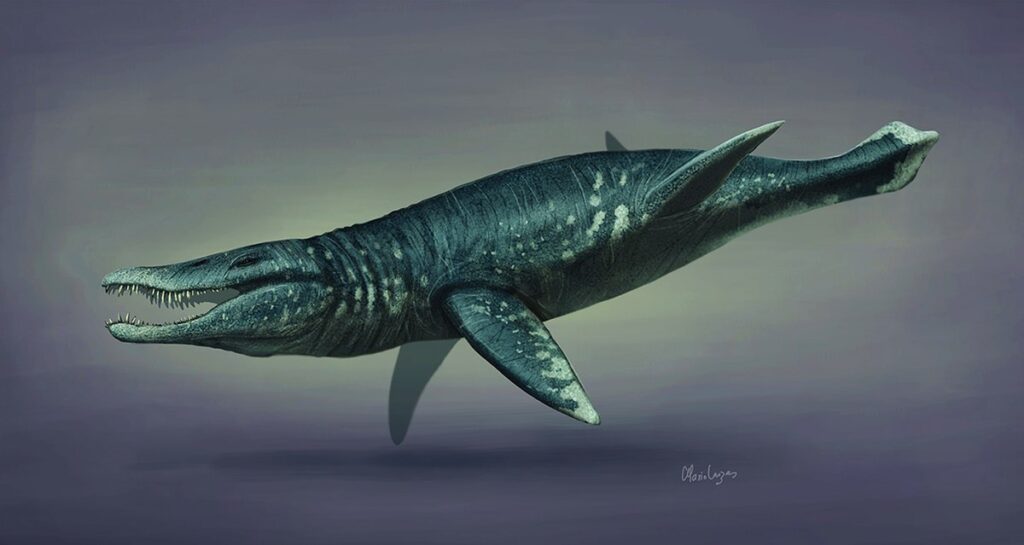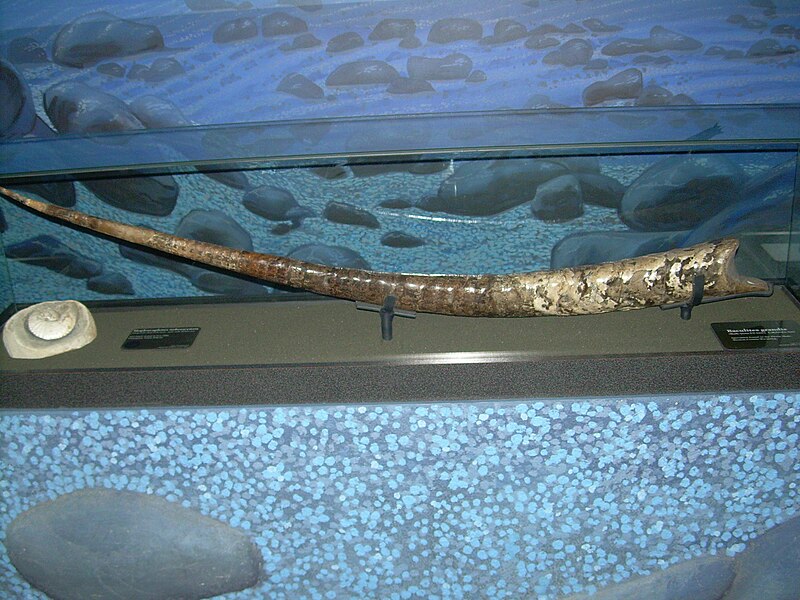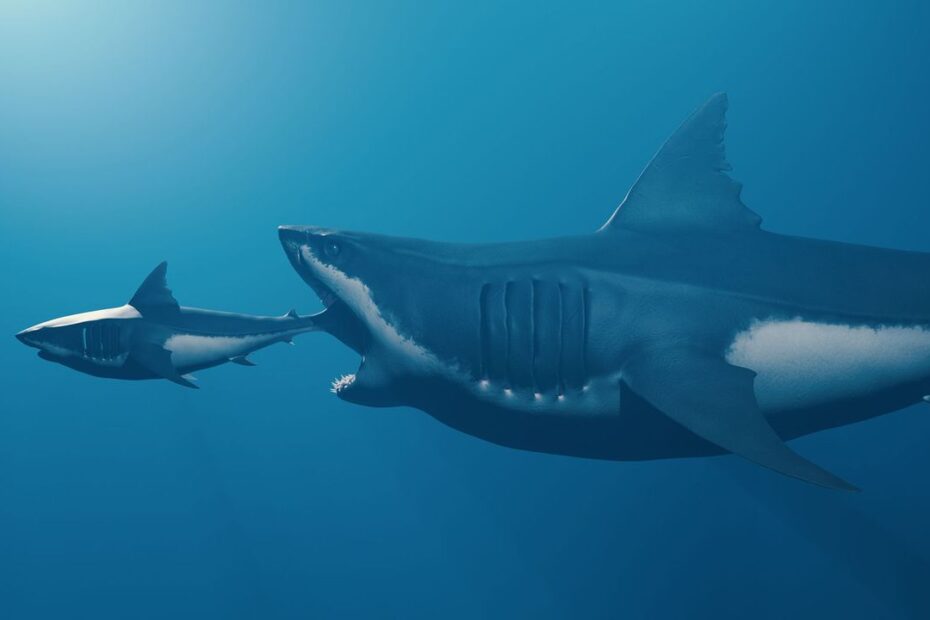The Earth’s oceans have harbored an incredible array of life throughout its history, with some of the most awe-inspiring creatures to ever roam the seas now long extinct. These marine giants, with their colossal sizes and unique adaptations, once ruled the ancient oceans. In this exploration, we will delve into the depths of history to uncover the fascinating stories of the 10 largest extinct sea creatures, showcasing the incredible diversity of prehistoric marine life.
1. Megalodon: The Apex Predator of Ancient Seas (Largest Extinct Sea Creature #1)
The Megalodon, often referred to as the “monster shark,” holds the title of the largest predatory fish to have ever existed. With estimated lengths reaching up to 82 feet, this prehistoric shark dominated the oceans approximately 23 to 3.6 million years ago. Its massive size, powerful jaws, and serrated teeth made it an apex predator, preying on marine mammals and large fish.
Megalodon, the colossal prehistoric shark, reigned as one of the largest and most formidable predators to ever roam the oceans. This apex predator lived approximately 23 to 3.6 million years ago, during the Cenozoic Era, and is now extinct. Belonging to the family Otodontidae, Megalodon dwarfed even the great white shark in size, with estimates suggesting it could reach lengths of up to 82 feet (25 meters) or more.
The Megalodon’s iconic serrated teeth, some measuring over 7 inches (18 cm) in length, provide valuable insights into its diet and hunting strategies. These massive sharks were likely apex predators, preying on a variety of marine mammals, including whales and seals. The sheer power and size of Megalodon allowed it to dominate the ancient seas, making it an awe-inspiring and terrifying force.

Image Courtesy: https://www.bbc.com/future/article/20230801-megalodon-the-superpredator-that-ate-its-siblings-in-the-womb
Despite its extinction millions of years ago, Megalodon continues to capture the imagination of scientists and the general public alike. The mystery surrounding its disappearance adds an extra layer of intrigue to this ancient giant, and its legacy lives on through fossils, research, and popular culture depictions in books, movies, and documentaries. The study of Megalodon remains a fascinating avenue for paleontologists, unlocking clues about Earth’s ancient oceans and the evolution of marine life.
2. Liopleurodon: The Jurassic Sea Serpent (Largest Extinct Sea Creature #2)
During the Late Jurassic period, the Liopleurodon patrolled the seas with its formidable presence and was among largest extinct sea creatures. This massive marine reptile, often described as a sea-going crocodile, boasted an estimated length of 23 to 33 feet. Its streamlined body and powerful limbs allowed it to navigate the ancient oceans with grace, preying on smaller marine life.
Liopleurodon is an extinct marine reptile that lived during the Middle Jurassic period, approximately 160 to 155 million years ago. Belonging to the Pliosauroidea group, it was a formidable predator that ruled the ancient seas. Liopleurodon was an apex predator, and its name translates to “smooth-sided tooth.” This name is derived from the smooth enamel surface of its conical teeth, which were well-suited for capturing and gripping slippery prey.
This marine reptile was an enormous creature, with estimates suggesting lengths of up to 20 feet or more. It had a streamlined body, powerful flippers, and a large head equipped with sharp teeth. Liopleurodon likely preyed on a variety of marine animals, including fish, squid, and even other marine reptiles.

Image Courtesy: https://www.amazon.in/Safari-Ltd-300529-Liopleurodon/dp/B00B3YM0WS
Despite its massive size, Liopleurodon was a skilled swimmer, capable of covering large distances in search of prey. Fossil discoveries of Liopleurodon have been made in various locations, including England and France. As with many prehistoric creatures, our understanding of Liopleurodon is continually evolving as new fossils are discovered and scientific research advances. The formidable appearance and mysterious nature of Liopleurodon continue to capture the imagination of paleontologists and enthusiasts alike.
3. Ichthyosaur: The Fish Lizard (Largest Extinct Sea Creature #3)
The Ichthyosaur, meaning “fish lizard,” was a group of marine reptiles that flourished during the Mesozoic era. These streamlined creatures resembled modern dolphins and had lengths ranging from 1 to 23 feet. Ichthyosaurs were highly adapted for a marine lifestyle, possessing large eyes for low-light conditions and fins for efficient swimming. It is also ranked among largest extinct sea creatures.
Ichthyosaurs were a diverse group of marine reptiles that lived during the Mesozoic Era, from the Early Triassic to the Late Cretaceous, roughly 250 to 90 million years ago. These fascinating creatures evolved from land-dwelling reptiles, adapting to an entirely aquatic lifestyle. Their name, derived from Greek words meaning “fish lizard,” aptly describes their streamlined bodies and fish-like features.
Ichthyosaurs displayed a range of sizes, from small species measuring a few feet in length to giants like Shonisaurus, which could reach lengths of up to 69 feet. They had sleek, torpedo-shaped bodies with large eyes, indicating their adaptation to a life in the open ocean. Powerful tail fins allowed them to navigate and propel themselves through the water with remarkable agility.

Image Courtesy: https://www.bbc.com/news/uk-england-york-north-yorkshire-43652968
These reptiles were carnivorous, preying on fish and other marine organisms. Fossil evidence suggests that some ichthyosaurs gave birth to live young, unlike many other reptiles of their time.
Ichthyosaurs left an extensive fossil record, and their remains have been discovered on every continent. Studying these fossils has provided valuable insights into the evolution of marine life and the complex ecosystems that existed during the Mesozoic Era. Despite their extinction around the same time as the dinosaurs, ichthyosaurs remain a captivating subject of paleontological research, shedding light on Earth’s ancient oceans and the diversity of life that once inhabited them.
4. Basilosaurus: The Serpent of the Eocene (Largest Extinct Sea Creature #4)
Named after the mythical basilisk, the Basilosaurus was a massive whale that inhabited the oceans around 40 to 34 million years ago. Despite its name, it was not a true reptile but a primitive whale with an elongated body, reaching lengths of up to 60 feet. The Basilosaurus was a dominant predator, preying on fish and smaller marine mammals.
Basilosaurus, meaning “king lizard,” is a prehistoric marine mammal that lived approximately 40 to 34 million years ago during the Late Eocene period. Despite its name, Basilosaurus is not a lizard but rather a primitive whale. It belonged to the archaeoceti group, an early lineage of whales that had certain terrestrial features, such as hind limbs, indicating their evolutionary transition from land to sea.

Image Courtesy: https://extinctmonsters.net/2014/12/10/extinct-monsters-basilosaurus/
Basilosaurus was an impressive creature, reaching lengths of up to 60 feet (18 meters). It had a serpentine body with elongated jaws filled with sharp teeth, suggesting a carnivorous diet. Unlike modern whales, Basilosaurus had small, non-functional hind limbs, which were remnants of its terrestrial ancestors.
Fossils of Basilosaurus were first discovered in the southern United States in the 19th century, providing valuable insights into the evolution of whales. The species was initially thought to be a marine reptile, hence the name “king lizard.” However, further research confirmed its mammalian nature.
Studying Basilosaurus contributes significantly to our understanding of the evolutionary history of whales and the transition from land to sea, shedding light on the fascinating adaptations that occurred during this process.
5. Dunkleosteus: The Armored Titan (Largest Extinct Sea Creature #5)
Dunkleosteus, a prehistoric fish from the Late Devonian period, is renowned for its impressive size and armored appearance. With an estimated length of 33 feet, this massive fish had a heavily armored head and sharp, beak-like jaws. Dunkleosteus was a fearsome predator, using its powerful bite to crush and consume other armored fish.
Dunkleosteus was a prehistoric fish that lived during the Late Devonian period, approximately 360 million years ago. Belonging to the placoderm group, Dunkleosteus was one of the largest and most fearsome predators of its time. Fossils of this ancient fish have been found in North America, Europe, and Morocco.
One of Dunkleosteus’ distinguishing features was its massive jaw, equipped with sharp, serrated bony plates instead of teeth. These plates formed a beak-like structure, and the fish likely used them to crush and slice through the armor of its prey. With an estimated length of up to 33 feet (10 meters) and a heavily armored head, Dunkleosteus was a formidable hunter in the Devonian seas.

Image Courtesy: https://shop.childrensmuseum.org/products/dunkleosteus
Despite its impressive size and predatory adaptations, Dunkleosteus belonged to a group of fishes that eventually went extinct by the end of the Devonian period. The exact cause of their extinction remains uncertain, but changes in environmental conditions and competition with other marine life are among the proposed factors. Dunkleosteus is a fascinating example of the diverse and sometimes bizarre life forms that inhabited Earth during ancient times.
6. Pliosaurus: The Jurassic Leviathan (Largest Extinct Sea Creature #6)
Pliosaurs, a subgroup of marine reptiles, included giants like the Pliosaurus. These creatures existed during the Jurassic and Cretaceous periods, with the Pliosaurus reaching lengths of up to 40 feet. With a massive head and powerful jaws, it was an apex predator in its ecosystem, preying on fish, squid, and even other marine reptiles.
Pliosaurus is a genus of marine reptiles that lived during the Late Jurassic period, approximately 150 million years ago. Belonging to the family Pliosauridae, these formidable predators were among the largest marine reptiles ever to exist. Pliosaurs, including Pliosaurus, were characterized by their powerful build, with short necks and large heads featuring robust jaws filled with sharp teeth.
Pliosaurus species were well-adapted for a life in the oceans, possessing streamlined bodies and paddle-like limbs for efficient swimming. Some species reached lengths of up to 40 feet or more, with the iconic Pliosaurus funkei being one of the largest known pliosaurs. Its skull alone could measure over 7 feet, indicating a formidable apex predator.
These marine reptiles were carnivorous hunters, likely preying on a variety of marine animals, including fish, ichthyosaurs, and other marine reptiles. Their strong jaws and teeth suggest they were capable of taking down large prey with ease.

Image Courtesy: https://commons.wikimedia.org/wiki/Category:Pliosaurus
Fossils of Pliosaurus have been discovered in various locations around the world, including Europe and South America. These findings have provided valuable insights into the prehistoric oceans and the diverse marine ecosystems that existed during the Jurassic period. Pliosaurus remains a fascinating subject of study, shedding light on the ancient marine world and the incredible adaptations of apex predators from the distant past.
7. Tylosaurus: The Mosasaur King (Largest Extinct Sea Creature #7)
During the Late Cretaceous period, the Tylosaurus, a giant marine lizard known as a mosasaur, ruled the oceans. With an estimated length of 45 feet, it was an apex predator with a streamlined body and powerful tail for efficient swimming. Tylosaurus preyed on fish, ammonites, and other marine reptiles.

Image Courtesy: https://a-z-animals.com/animals/tylosaurus/
8. Kronosaurus: The Queensland Sea Monster (Largest Extinct Sea Creature #8)
Hailing from the Early Cretaceous period, the Kronosaurus was a formidable marine reptile that patrolled the ancient seas around Australia. With an estimated length of 30 to 33 feet, this pliosaur had a short neck, large head, and powerful jaws. Kronosaurus was a dominant predator, feeding on fish, squid, and other marine creatures.

Image Courtesy: https://www.thoughtco.com/things-to-know-kronosaurus-1093790
9. Elasmosaurus: The Long-Necked Titan (Largest Extinct Sea Creature #9)
Elasmosaurus, a marine reptile from the Late Cretaceous period, was characterized by its exceptionally long neck. With an estimated length of up to 46 feet, it had a body resembling that of a plesiosaur, with a small head and a flexible neck. Elasmosaurus likely used its long neck to reach and capture prey in the water.

Image Courtesy: https://www.thoughtco.com/facts-about-elasmosaurus-1093328
10. Baculites: The Straight-Shelled Ammonite (Largest Extinct Sea Creature #10)
Although not a creature in the traditional sense, Baculites deserves mention for its fascinating role in ancient oceans. Baculites was an extinct group of straight-shelled ammonites that thrived during the Late Cretaceous period. With lengths reaching up to 6 feet, these cephalopods played a crucial ecological role as both predator and prey.

Image Courtesy: https://en.wikipedia.org/wiki/Baculitidae
The ancient seas were home to an astounding array of colossal and diverse creatures, each contributing to the intricate web of marine life. The 10 largest extinct sea creatures showcased here provide a glimpse into the richness of prehistoric oceans, where apex predators, gentle giants, and bizarre forms of marine life coexisted. Studying these ancient giants not only helps us understand the history of life on Earth but also underscores the dynamic nature of evolution and adaptation in the ever-changing marine environment. The legacy of these extinct sea creatures lives on in the fossils and remnants discovered by paleontologists, offering valuable insights into the mysteries of our planet’s past.
Featured image courtesy: https://www.bbc.com/future/article/20230801-megalodon-the-superpredator-that-ate-its-siblings-in-the-womb
